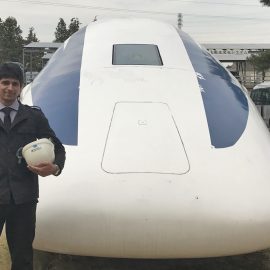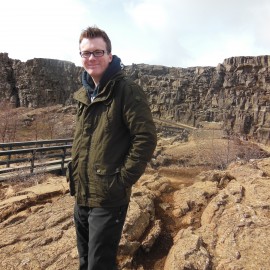Research Project Index
|
Correlating ballast stiffness/settlement and sub-ballast behaviour with trackbed performance and maintenance needs
 Ali Shahbaz Khan Ali Shahbaz Khan
I graduated with BEng in Mechanical Engineering (2015) and MSc in Chemical and Petroleum Engineering (2016) from the University of Bradford.
My research project ‘Correlating ballast stiffness/settlement and sub-ballast behaviour with trackbed performance and maintenance needs’, is part of an EPSRC sponsored research programme, “Track to the Future (T2F)”. The project aims to contribute towards an efficient and robust railway track with improved performance prediction and maintenance planning.
Project Funders: Track to the Future
Project Details: In laboratory experiments and field monitoring of railway tracks, we tend to focus on the elastic (in cycle) stiffness and the accumulation of plastic (permanent) settlements over millions of loading cycles. However in reality, it is the development of differential settlements and lateral movements that drive maintenance needs. Variations in track level are characterised by the standard deviation (from the smooth ideal) over typically a 35 m wave length. The challenge is to link the measureable and quantifiable parameters of elastic stiffness and the development of permanent settlement to these from the often seemingly random deviation of the track from the desired line and level. The project will start with a review and critical appraisal of current approaches and models for the prediction of ongoing track geometry deterioration, which are largely empirical and based on relatively little data. Data obtained from T2F field study sites will be used to develop new correlations, back-referenced to the laboratory sleeper testing rig data generated by others. Modelling using 3D dynamic finite element analyses incorporating soil models able to reproduce the accumulation of plastic settlement with cyclic load, controlled spatial variability in the sub-base (soil or ballast thickness, stiffness and type) and initial defects that attract loading anomalies, will then be carried out to investigate the forms and magnitudes of variability leading to geometry deterioration as quantified by the development of standard deviation. The applicability of a stochastic approach will also be investigated. The new findings will be used to improve current approaches or develop new ones, which will then be incorporated into integrated T2F models for improved track performance prediction and maintenance planning. |
Track noise mitigation
 Boniface Hima Boniface Hima
I came to in UK 2006 from Tanzania and later on join the British Army’s Royal Engineer corps as a specialist driver, where I served for 5 years and left in 2012 to pursue further education. I graduated in 2015 from Southampton Solent University with BSc (Hons) in Sound Engineering and was awarded scholarship to attain an MSc in Applied Acoustics, I graduated in 2016 at the same university. I successfully secured a part-time job as assistant acoustics consultant while attaining MSc.
While working as assistant consultant, I was involved in varieties of projects that involve noise reduction. The projects gave me exciting passion in finding the best ways of creating a solution to the problems that associated with noise.
My project is entitled “Track Noise Mitigation”. This project is jointly funded by The Engineering and Physical Sciences Research Council and Track to the future. The aim of the project is to carry out computer modelling combining rolling noise and ground-borne vibration to design a low noise/ low vibration track.
Project funders: Track to the Future
Project details: Noise and vibration are generated by forces at the wheel/rail interface and radiated through vibration of the wheel and the track. For modern vehicles running on modern track the contribution of the track is known to be dominant. Therefore strategies to reduce the noise of the track promise significant reductions of overall noise if successful. A number of existing techniques are available. However, the challenge is to introduce noise mitigation without increasing the cost or complexity of the track significantly. The project will make use of state-of-the-art modelling tools to assess various combinations of noise control measures, such as damping treatments, changes to the rail support system, shielding close to the rail and the introduction of absorbent materials. A reduced scale railway track facility is available which will be used for laboratory testing on scale model components to validate the theoretical models and to gain fundamental understanding of the mechanisms involved. It is intended within T2F to build a demonstrator low-noise, low-vibration track and to assess the costs and benefits in economic modelling.
|
Novel forms of railway track
 Toshan Rampat Toshan Rampat
Toshan Rampat’s research is in fundamental soil mechanics, granular behaviour and numerical modelling. More specifically, the research involves the coupling of finite element models and discrete element models in order to simulate the behaviour of high-speed trains on ballasted tracks. He is currently involved in the project TRACK TO THE FUTURE (T2F) where he is developing new forms of railway sleepers.
After graduating from the University of Nottingham with a Bachelor in Civil Engineering in 2015, he pursued one year of research, as a Geotechnical research and teaching assistant, for the project: From Conventional to High-Speed, which involved the investigation of various types of reinforcement schemes using 3D-geocomposite materials on ballasted for rapid transit applications.
His professional experience includes design of shallow foundations using Eurocode 7 and on-site supervision. He has previously worked with Pad&co Ltd, Hyvec Partners Ltd and LuxConsult Ltd.
He was awarded the Best Paper Award at the ICCEASCM 2016 conference held in Kuala Lumpur.
Project Funders: Track to the Future
Project Details: Although modern railway sleepers are generally made of reinforced concrete, they have retained the prismatic shape of the timber sleepers they replaced. While twin block sleepers as used on some railways such as SNCF may be advantageous in terms of reducing track settlements, they have disadvantages including an increased susceptibility of the rails to lose track gauge (move relative to one another) and are not suitable in ground conditions aggressive towards steel. The aim of this project is to investigate the potential for differently, more efficiently-shaped sleepers to improve track robustness and reduce maintenance needs. Track forms that might be investigated include broader or dumb-bell shaped sleepers, with the bulk of the material placed where support is most needed, segmented ladder and hybrid tracks. The project will include the experimental investigation of sleeper/ballast bed performance over millions of loading cycles in purpose-built test rigs at Southampton and/or Nottingham; numerical discrete element method (DEM) modelling using techniques developed at Southampton and Nottingham to identify micromechanical behaviours and help explain the observed behaviour; and dynamic finite element analyses using suitable continuum models for the ballast and the supporting soil to assess load transfer and other macroscopic effects. There will also be the opportunity to help specify and become involved in field testing of novel track forms and interventions, through the EU-funded Shift2Rail programme. The results will be incorporated into integrated T2F models for improved track performance prediction and maintenance planning. |
Optimising wireless electric vehicle charging locations
 Luke Hutchinson Luke Hutchinson
I graduated in 2015 from Oxford Brookes University after initially completing a BSc in Motorsport Engineering and then progressing onto an MSc in Mechanical Engineering. I have a strong interest in Sustainable Engineering and have undertaken research projects into renewable energy production technology and the integration of natural materials into modern vehicle construction.
Research Interests
- Renewable Energy Production
- Energy Losses in Transportation
- Wireless Power Transfer
- Control Theory
- Autonomous Vehicles
- Sustainable Transportation
Project Funders: TRL
Research Project: Dynamic Wireless Power Transfer systems, where electric vehicles receive a power charge as they travel along the road have the potential to significantly extend the range and usability of such vehicles.
While much research has taken place examining the optimal location distribution of traditional (plug-in) charging points however, the optimal distribution of wireless charging infrastructure, both in isolation and in combination with plug-in systems has received little analysis.
This research therefore seeks to create a modelling framework that – given the inputs of a network, driver requirements and the infrastructure capabilities – can attempt to optimize the distribution of both wireless charging systems and plug-in charging stations within the network.
It is anticipated that the creation of such a modelling framework will require developing and combining ideas and approaches from….
- Mathematics/Operational Research : Scheduling and resource optimisation (including heuristic approaches)
• Complexity Science : Agent based models to represent traveler behavior such as route choice
• High performance computing : Using the University’s IRIDIS cluster
…. to understand how the locations of wireless charging systems can affect the overall dynamics of the road transport network.
This project is in partnership with the Transport Research Laboratory (TRL) (www.trl.co.uk) and it is anticipated that extended placements at TRL will form part of the research activities. |
Novel Sensors for Condition Monitoring of Earthworks
 Gerardo Espindola Garcia Gerardo Espindola Garcia
Graduated in 2010 from Universidad Autónoma de Nuevo Leon in México with a BSc degree in Mechatronic Engineering; From 2010-2014, he worked for a manufacturing company as Research, Development and Automation Engineer where he was in charge of the automation of the production lines of manufacture and decoration of PET containers as well as the R&D of new products and decoration techniques related to PET products. In 2015 he completed his MSc in Advanced Mechanical Engineering with Mechatronics as main topic in the University of Southampton and joined the iPhD program at CDT-SIS group.
The aim of his research is to develop novel sensors using embedding rugged thick film electrodes in earthworks trying to detect changes in soil parameters such as conductivity and water content and determine if those changes are indicative of earthwork displacement.
Project Funders: RSSB
Project Details: Standard approaches for monitoring earthwork stability involve installation of tilt sensors (inclinometers) and pore water pressure sensors into boreholes. The need to drill boreholes to install these at some depth makes them costly to install. Low-cost condition monitoring using near-surface sensors over long lengths of railway earthworks is very desirable, but there remain significant challenges to the reliability of such a system.
The project will investigate embedding low cost and rugged thick film (TF) electrodes in earthworks to see if they can detect changes in soil parameters such as soil conductivity/water content and total earth pressure (as opposed to pore water pressure), that could indicate earthwork displacement (or even the potential for displacement) in cuttings and embankments. A key part of the project will be in trying to determine the extent to which any detected changes in sensor outputs (conductivity, total pressure) are indicative of earth movement or incipient movement.
It is anticipated that gross, sudden or abrupt changes in sensor output are very likely to result from actual displacement of earthworks but it is also an aim of the project to try to establish whether sensor output changes can also be indicative of the likelihood of displacement occurring (such as differential pressure e.g. differences in readings recorded at the top and bottom of slopes).
The project will: i) design and print the TF sensor; ii) test it in the laboratory using soil column and sandbox tests; iii) install sensors in a real slope(s) to test their practical ability; and iv) propose a framework in which the sensors can be used to assess the risk of slope failure based on known properties (geometry, soil type, vegetation cover) of the earthwork. |
Mitigating Range Anxiety and Reducing Energy Consumption by Drivers in Electric Vehicles
 Richard Deacon Richard Deacon
I studied psychology to BSc at the University of Southampton, and continued on to study research methodology to Master’s level. In September of 2015 I joined the CDT-SIS, Transport Research Group to study for an iPhD.
My specific field of interest is the way in which humans interact with technology and machines.
Project Funders: Jaguar Land Rover
Project Details: The way in which a motor vehicle is driven and the type of technologies that are selected both have a significant effect on the amount of energy that is used. Given the issues of the over use of resources and the emission of large volumes of carbon dioxide (and equally damaging pollutants), the aim of this project is to encourage energy-conserving driving behaviors and reduce range anxiety through the design of an in-vehicle information system. Whilst there have been a number of studies investigating the use of visual tools to help drivers save fuel, with varying success rates, each of these tools carry with them the issue of visual distraction. To address the problems of range anxiety, energy conservation and driver distraction, a series of studies are planned in the Southampton University Driving Simulator, that will investigate a variety of different information presentation methods, and their effects on driving performance. Theoretical justification and design rationale find basis in the principles of Ecological Interface Design, an approach to design rooted in Gibsonian ecological psychology. Range anxiety is a major factor in preventing the uptake of Electric Vehicles. There are infrastructure enablers for this project to be successful, such as iBeacons to transmit road context data to vehicles, combined with satnav data and intelligent traffic lights. To be effective will require joined-up thinking in communication between infrastructure, vehicle design and Human Factors engineering. Human Factors in the design and operation of road vehicles has much to offer in providing solutions to this problem in the form of on-line and off-line guidance and support to the driver, to help them understand the factors constraining range and the effects that their behavior can have on the energy consumption (and energy regeneration) of the vehicle. This project aims to test the effects of new driver interfaces that will be developed in the project on range anxiety and energy consumption. It is anticipated that this project will help to realise the promise of electric vehicles in developing Sustainable Infrastructure Systems to support their deployment in the future. |
Vulnerability of Railway Earthworks to Future Extreme Weather Events
 Miguel Vivas Mefle Miguel Vivas Mefle
I am an MSc graduate in Civil Engineering from the University of Granada (Spain) and an MSc graduate in Geotechnical Engineering from the University of Birmingham. My work experience consists of more than 9 years working as CDM Co-ordinator and Design Engineer in Motorways and High Speed Railways projects of singular relevance in Spain.
Currently, I am undertaking an IPhD in the Centre for Doctoral Training in Sustainable Infrastructure System (CDT-SIS) at the University of Southampton in a research jointly funded by the Engineering and Physical Sciences Research Council (EPSRC), the University of Southampton, Network Rail and Amey.
My research interests are in the field of Slope Stability Analysis in saturated and unsaturated soils and the effects of multiple variable factors in the slope stability as vegetation, temperature, rainfall or compaction degree, among others.
Project Funders: RSSB
Project Details: Extreme weather events are predicted to increase in frequency according to many future climate scenarios. Such events can have a devastating impact on railway earthworks, for instance flooding leading to scour and wash out of embankments, extreme rainfall leading to ultimate slope stability failure and extended hot dry summers causing embankment swelling and consequential rail deformations. Changes in climate patterns also mean that currently known problematic earthwork sites may not be those most at risk in the future.
Detailed research at specific sites can lead to an improved understanding of earthwork vulnerability at a local level, but the challenge remains in upscaling this knowledge to be able to apply quantitative risk assessment of earthwork vulnerability over a network scale. This project will investigate the use of readily available earthwork asset management information and how this may be linked to the vulnerability of individual assets in the rail network. This can then be applied to 1) the identification of those sites most at risk and therefore in need of targeted renewals and 2) assessment of the vulnerability of the network as a whole.
Our railway network is an essential piece of infrastructure for UK PLC, enabling commuting, business and tourism. Its future sustainability is dependent on identifying which parts of the network may be vulnerable to a changing climate and acting to improve its resilience in those areas.
|
Addressing the new reality of vehicle automation in highway design
 Hameed Jehanfo Hameed Jehanfo
In 2006 I graduated with a BSc(Hons) in Civil Engineering from the Kwame Nkrumah University of Science and Technology. I then relocated to the UK after graduation, before joining Mouchel as a graduate engineer in 2007. After working in various UK-based civil engineering consultancy roles, I qualified as a chartered engineer with the Institute of Civil Engineers (ICE) in 2016.
In light of the apparent inevitable uptake of autonomous vehicles, my PhD theme will investigate the extent to which the requirements of highway design parameters can/or need to change, given the reduced human driver input in self-driving vehicle as compared to ‘conventional’ fully manual vehicles.
Project Funders: EPSRC
Project details: Significant strides have been made by governments and private organisation towards the successful implementation of connected and autonomous vehicles (CAVs) into mainstream road transport. The magnitude of the investments made by various stakeholders demonstrates a real determination to ensure that this ambition is realised. Although the technologies for autonomous driving are being developed to work on the highway network as currently designed, there exists an opportunity to harness the capabilities provided by self-driving vehicles to optimise highway engineering designs.
This research will investigate the influence that varying degrees of vehicle automation could have on optimising highway design features in terms of various criteria, such as traffic efficiency, safety and environmental sustainability. |
Ground support and modelling through railway switches & crossings and transitions
 Giacomo Ognibene Giacomo Ognibene
Project Funders: Network Rail
Project details: One of the most imporant components of the railway system are switches and crossings (S&C). They provide flexibility to the system in terms of feasible routs. However, even though they represent less than 1% of the entire route length of railways in the UK, they are also one part of the railway system with the highest number of degradation modes and failures. This results in a high cost for infrastructure managers in inspection, maintenance, delay minutes and renewal. In the UK, they take up to 20% of expenditure on track maintance and in the worst case, may have a working life of only 3 years.
The aim of this project is the development of innovative S&C designs that allow for increased axle loads and speeds with a decrease for maintenance. This will be achieved by developing new understandings of the high complex interactions between switch and crossing geometry.
The project will consist in three different steps. First, the development of a finite element model of an existing turnouts which an represent irs long-term behaviour. This model will simulate the long-term behavior of the S&C, accounting the principal damage mechanism (i.e. wear, accumulated plastic deformation). Then, the model will be calibrated through laboratory and field tests and validated. Finally, an algorithm will be applied to find an optimum design solution in terms of support stiffness and geometry. |
Ports of the Future: identifying the separate objectives of ports and cities, and the alignments, tensions and legislation demands
 Toby Roberts Toby Roberts
I studied BSc (Hons) Geography at the University of Plymouth and MSc Sustainable Development (Climate change and risk management) at the University of Exeter. Throughout my education I have enjoyed studying both the physical and human sciences relating to climate change and sustainability.
Project Funders: Ramboll
Project details: Ports are at the forefront of many of the key issues of our times, such as urbanisation, globalisation and sustainability. It is therefore of great importance that ports are able to operate more effectively in the future, whilst reducing detrimental impacts to the environments around them. Due to the close proximity of port areas to cities, tensions have developed in relation to issues such as pollution, energy usage and traffic congestion. This project aims to identify the separate objectives of ports and cities. This will hopefully identify which areas create tension and which areas can be aligned, leading to more cooperative relations. The final goal is to produce an independent and objective guidance document to assist ports and cities to focus on symbiotic successful infrastructure development |
A Whole Life Carbon Model for Railway Track System Interventions
 Georgios Rempelos Georgios Rempelos
Project Funders: Network Rail and EPSRC
Project details: Georgios’ project aims to develop a carbon emissions model for railway track systems, covering the whole life of infrastructure. The model will be capable of modelling the impacts of a wide range of track system interventions, including the full range of engineering solutions developed during the Track to the Future research programme. The model will have a high degree of spatial transferability, which will allow it to be used to generate results for any part of the UK rail network. |
Tribocorrosion of Marine Systems and Infrastructure
 Keiran Ball Keiran Ball
Project Funders: EPSRC
Project details: Tribocorrosion is the interaction of a wear mechanism and corrosion on a metallic surface. There are various types of wear mechanisms, including adhesive, abrasive and erosive wear. I will be focusing more specifically on erosion and its interaction with corrosion in marine environments. There are many applications where this phenomena is relevant and impacts the service of different engineering systems, from that ship and submarine propellers, offshore oil rig platforms, underwater pipes and cables, as well as deep sea drilling equipment. There is a need to understand, mechanistically, the mechanisms of action of the process under various flow conditions. In marine conditions passive metals are used, meaning the metal forms a strongly adhesive, chemically inert layer in the scale of nano meters thick, which protect the metal from corrosion. However when this passive layer is disrupted by the impingement of a solid particle this can create an active site for chemical attack of the underlying metal. In most cases these redox reactions lead to repassivation of the protective layer, protecting the metal from attack. This process is both temporal and transient; a rough repassivation time for authentic stainless steels is given. However, under some conditions, this small area may grow and propagate until it causes pitting, which can detrimental to the engineering material and system. The problem is dramatically reduced service life and availability of plant or vessels which occurs due to an inability to predict the loss of material due to the combination of these material degradation mechanisms. Due to complex interplays in corrosive wear which are not fully understood, a 1mm3 /year corrosion and erosion rate will not lead to a 2mm3 /year tribocorrosion rate but can be many times larger. Clearly there is a necessity to understand the process and provide a model able to predict degradation of marine alloys, ranging from single phase austenitic SS to complex multiphase aluminium alloys. The aim of this project is to use novel experimental methods on a nanoscale to allow for an indepth analysis of the interplay between mechanisms in tribocorrosion. By looking at the disruption to a passive oxide layer and measuring the repassivation kinetics of a single scratch/indentation/impact, factors such a crystal structure, phase, topography and orientation can be identified as having an effect on the corrosion of the material. By integrating a state of the art corrosion model and erosion model and comparing with nanoscale test results a more in depth understanding of the processes will be obtained and a more accurate predictive model produced. The experiments will inform next generation modelling approaches that mirror real tribocorrosion mechanisms at the microstructural scale of alloys and coatings By better understanding these interactions we can perhaps understand the synergy between them, defining a relationship between erosion enhanced corrosion and corrosion enhanced erosion; leading to more accurate models and allowing for better material selection for conditions where tribocorrosion is a problem, leading to tribocorrosion resistant structures, systems and coatings. |












